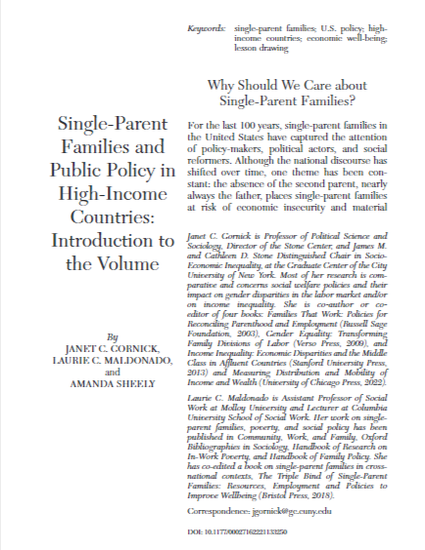
Article
Single-Parent Families and Public Policy in High-Income Countries: Introduction to the Volume
The ANNALS of the American Academy of Political and Social Science
(2022)
Abstract
This article is free to access.
For the last 100 years, single-parent families in the United States have captured the attention of policy-makers, political actors, and social reformers. Although the national discourse has shifted over time, one theme has been constant: the absence of the second parent, nearly always the father, places single-parent families at risk of economic insecurity and material hardship. Before the Second World War, it was widely assumed that mothers did not, and should not, work outside the home. Thus, the absent father implied the loss of the main or only family breadwinner, leaving the single mother and her children deserving of various forms of support, including the public provision of income. In subsequent years, a crucial change unfolded: single mothers were increasingly expected, and eventually pushed, into paid work. Their status as deserving of publicly provided supports diminished over time. Nevertheless, it remained understood, and it still does today, that a single breadwinner’s earnings are often not sufficient to secure a family’s economic well-being, especially when that single breadwinner is a woman.
Indeed, in the United States, it is well documented that single-parent families are much more likely to be poor than are families headed by couples; likewise, single-parent families headed by women are at greater risk of poverty than those headed by men. Today, about one in three single-mother families in the United States lives in income poverty (Wimer et al. 2021); and for many of these families, income poverty is compounded by food insecurity (Sheely 2022) and precarious housing (Edin and Shaefer 2015; Desmond 2016). Recently, it has been documented that single-parent families have been hit especially hard by the COVID-19 pandemic, due to both unexpected earnings losses and heightened demands on parents’ time.
The difficulties faced by many single-parent families raise a multitude of concerns, perhaps none more salient or more compelling than child poverty. While poverty is evident throughout the lifecycle—affecting children, prime-age adults, and the elderly—poverty among children has particular resonance. Child poverty captures our collective attention for several reasons: it is widely held that children need and deserve protection from hardship, most children have no control over their economic circumstances, deprivation during childhood can have lifelong consequences, and some of the effects of child poverty have spillover effects. Child poverty in rich countries is especially compelling, because it is rooted not so much in scarce aggregate resources but mainly in distributional arrangements, both private and public.
Keywords
- single-parent families,
- U.S. policy,
- high-income countries,
- economic well-being,
- lesson drawing
Disciplines
Publication Date
July, 2022
DOI
10.1177/00027162221133250
Citation Information
Janet C Gornick, Laurie C Maldonado and Amanda Sheely. "Single-Parent Families and Public Policy in High-Income Countries: Introduction to the Volume" The ANNALS of the American Academy of Political and Social Science Vol. 702 Iss. 1 (2022) p. 8 - 18 Available at: http://works.bepress.com/laurie-maldonado/25/
